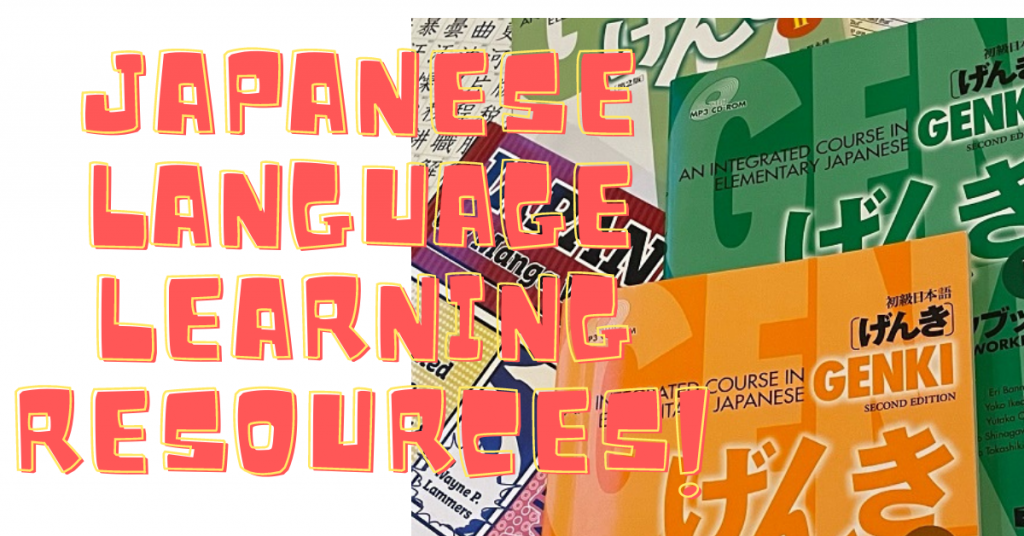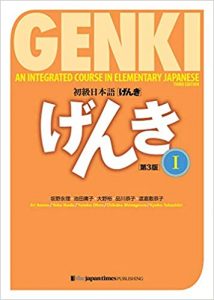
My Favorite Japanese Learning Resources
Of course, nothing is going to replace having real-life conversations, or an in-person class where the instructor can correct your pronunciation. But starting with books and audio/video resources will definitely get you moving forward, and can serve to supplement what you have learned and offer opportunity to study and practice on your own.
Try to choose resources that work with your current level. You want to challenge yourself, but you want to use resources that you understand just enough to get something out of each lesson – while learning something new. If you throw yourself into the deep end, you may quickly get overwhelmed or burnt out and decide the whole process is impossible. It’s okay if you feel like a kid. After all, you are, in essence, starting over where small children start – with basic sounds.
There are so many books and other resources out there, I couldn’t include everything here, so it is possible that your favorite isn’t on the list. These are just my go-to resources for learning Japanese.
Books:
 Genki 1 and Genki 2, Genki 1 Workbook and Genki 2 Workbook — When you start learning Japanese, you’re going to come across the Genki Textbooks. My husband and I are taking two on-line classes, one private and one group conversation, and both classes are using these textbooks. Genki 1 and Genki 2 are intended textbooks for college-level courses, and focus on vocabulary and grammar. You can also buy the workbooks that give more hands-on writing practice to supplement the exercises in the textbooks.
Genki 1 and Genki 2, Genki 1 Workbook and Genki 2 Workbook — When you start learning Japanese, you’re going to come across the Genki Textbooks. My husband and I are taking two on-line classes, one private and one group conversation, and both classes are using these textbooks. Genki 1 and Genki 2 are intended textbooks for college-level courses, and focus on vocabulary and grammar. You can also buy the workbooks that give more hands-on writing practice to supplement the exercises in the textbooks.
 Japanese the Manga Way – I also like Japanese the Manga way, because it gives practical examples of things that are somewhat dryly explained in the Genki Books. (I had so much trouble understanding which particles to use when, and this really helped!) It clearly breaks each example down by what the Japanese words literally say, and below there is a translation of what it actually means in English.
Japanese the Manga Way – I also like Japanese the Manga way, because it gives practical examples of things that are somewhat dryly explained in the Genki Books. (I had so much trouble understanding which particles to use when, and this really helped!) It clearly breaks each example down by what the Japanese words literally say, and below there is a translation of what it actually means in English.
 Remembering the Kanji – If you – like me – have trouble making kanji (the “picture words” you need learn to read/write Japanese on an adult level) stick in your memory, you may find this book’s approach to understanding them helpful. It gives the basic meaning of kanji, without focusing on the many possible readings (there are multiple ways to actually pronounce each kanji). There are mnemonic stories that will help you remember each one.
Remembering the Kanji – If you – like me – have trouble making kanji (the “picture words” you need learn to read/write Japanese on an adult level) stick in your memory, you may find this book’s approach to understanding them helpful. It gives the basic meaning of kanji, without focusing on the many possible readings (there are multiple ways to actually pronounce each kanji). There are mnemonic stories that will help you remember each one.
*** The book links above are affiliate links, but I do use these textbooks weekly.
Apps and Websites
Kana Mind (free — app) – Here’s a good place to start, if you are just beginning to learn, because being able to read basic texts is key to actually learning the language. Kana Mind is a matching game to learn the basic Japanese writing systems, and there are no beginning and end points, so you can practice a few minutes at a time while waiting in line. You can choose if you want to learn Katakana or Hiragana or both at the same time. I recommend learning – and practicing – both together.
WaniKani (first two levels are free, after that paid — website) – You want to know your basic kana before attempting this app (master Kana Mind to 100% proficiency at least once first). WaniKani breaks down kanji starting from the basic particles and building from there to teach you kanji and kanji combined with kana to form vocabulary. It uses mnemonics and visualization exercises to help the meaning and pronunciation stick. Try the free option, and if you stick to it long enough to get to the level that requires a paid subscription (they do have subscription sales, you’ll know if it’s a valuable resource for your learning style. (Pair with Remembering the Kanji, above.)
Kanji-Q (free — app) – If you want to write kanji as well as read it, this app can be helpful. It allows you to trace out stroke order (the order and direction in which you write each line of a character) with a stylus. What I like about this one is that you see the actual motion of the sample strokes being written. Then as you practice, you can turn off the sample, write your own strokes with the stylus, then turn the example back on to see how well you remembered it. You can also look up kanji using the radicals.
Memrise (Free, but much of the content requires paid premium access — app) – There are a number of memorization apps out there. Some people swear by Anki or Quizlet (both also good options), but what sold me on Memrise is the fact that someone did a course that breaks down all the vocabulary from the Genki Textbooks so that you have a review for each word in the vocabulary lists and the additional word charts from each book. (This is one of the free courses that Memrise offers. Many of the other courses will allow you to sample a section or two for free, but them require premium access to continue.) The other thing I like about Memrise is that you can put custom vocabulary into a spreadsheet and then import that entire spreadsheet into a new, private course. It has a built-in spaced repetition logarithm to optimize card content retention.
Imiwa (Free — app) – Every language learner needs a good dictionary, and this app serves that purpose well, translating back and forth between English and Japanese, and listing possible readings for the kanji involved. You can also use the analyzer function to paste in blocks of Japanese text to have them broken down with romanized characters and furigana (the pronunciation kana that you sometimes see above kanji).
Satori Reader (Free, but paid option required to access all articles – app) – This app helps you to actually start reading in Japanese, and you can choose content and reading ability at your level. You can also pull information out of the stories to learn, with a flashcard option.
Todai Easy Japanese News (Free, but also has paid premium version – app) – This app ties back to preparing for the JLPT Exam (Japanese Language Proficiency Test) with highlighted vocabulary in each article specifically suited to exam preparation (and marked with the exam level).
That Japanese Man Yuta (YouTube Channel) – If you’re looking for context and want to hear it from a native speaker, he gives many examples and lots of insight into what works and what doesn’t
Onomappu (YouTube Channel) – His videos are short and focus on practical applications with subtitles in both Japanese and English.
Speak Japanese Naturally (YouTube Channel) – If you’re working on pronunciation, this channel can be helpful. Japanese language instructor Fumi has an entire playlist just focusing on pitch accent and intonation.
Japanesepod101 (podcast, YouTube Channel) – They have a podcast with “survival phrases” that allows for on-the-fly practice. They also have a number of YouTube resources for phrases and audio practice, with everything from basic pronunciation to listening quizzes. Some of their videos play for four or five hours, so you can put it on in the background while doing laundry, or assembling a jigsaw puzzle, or whatever without having to frequently stop to play a new video.
Tofugu (Free – website, podcast) – There’s a language hub with articles on specific grammar questions, along with a podcast that offers a huge backlist of content of interest to Japanese language learners (some specifically linguistics, but other interviews and such on how to use the language skills you’ve learned).
I know this is a lot – so if you are new to Japanese, pick one or two of the resources that most appeal to you, instead of trying to experience everything at once. And don’t forget that learning can be fun!

